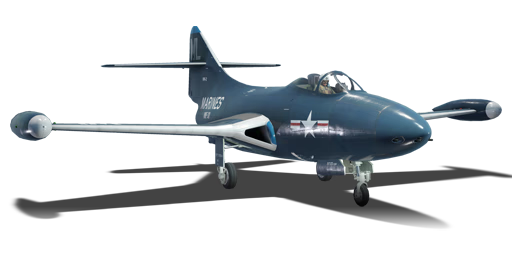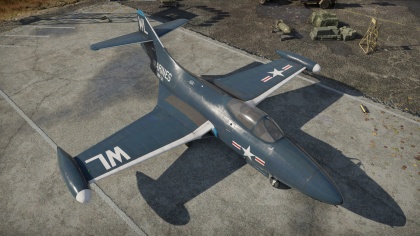F9F-2
Contents
| This page is about the aircraft F9F-2. For other uses, see disambiguation pages for F9F or Panther |
Description
The F9F-2 Panther is a Rank American naval jet fighter
with a battle rating of (AB), (RB), and (SB). It was introduced in Update 1.37.
The Panther will typically find itself outclassed as it often faces against more advanced jet designs, such as the MiG-15 or Venom. However, it does excel in a support fighter role. Distracted opponents are easy prey when the Panther's high speed diving and maneuverability are applied correctly . When engaged 1 on 1 with other jet fighters, its flaws (low top speed) can be exposed. Defensively, the Panther has a uncanny ability to escape pursuing enemies when using its agility to your advantage. The Panther greatly excels at the Fighter-bomber role due to it's optional payloads.
General info
Flight Performance
| Characteristics | |||||||
|---|---|---|---|---|---|---|---|
| Stock | |||||||
| Max Speed (km/h at 0 m - sea level) |
Max altitude (meters) |
Turn time (seconds) |
Rate of climb (meters/second) |
Take-off run (meters) | |||
| AB | RB | AB | RB | AB | RB | ||
| 913 | 904 | 12,500 | 27.3 | 28.6 | 19.8 | 18.3 | 750 |
| Upgraded | |||||||
| Max Speed (km/h at 0 m - sea level) |
Max altitude (meters) | Turn time (seconds) | Rate of climb (meters/second) |
Take-off run (meters) | |||
| AB | RB | AB | RB | AB | RB | ||
| 939 | 926 | 12,500 | 26.8 | 27.0? | 34.1 | 26.5 | 750 |
Details
| Features | ||||
|---|---|---|---|---|
| Combat flap | Take-off flap | Landing flap | Air brakes | Arrestor gear |
| ✓ | ✓ | ✓ | ✓ | ✓ |
| Limits | ||||
|---|---|---|---|---|
| Wing-break speed (km/h) |
Gear limit (km/h) |
Combat flap (km/h) |
Max Static G | |
| + | - | |||
| 1,000 | 400 | 607 | ~16 | ~7 |
| Optimal velocities | |||
|---|---|---|---|
| Ailerons (km/h) |
Rudder (km/h) |
Elevators (km/h) |
Radiator (km/h) |
| < 620 | < 650 | < 720 | > 550 |
| Compressor (RB/SB) | ||
|---|---|---|
| Setting 1 | ||
| Optimal altitude | 100% Engine power | WEP Engine power |
| 0 m | 2260 kgf | No WEP |
Survivability and armour
- 9.5 mm Steel - Fore cockpit armor plate
- 9.5 mm Steel - Armor plate behind pilot's seat
- 60 mm Bulletproof glass - Windshield
Armaments
Offensive armament
The F9F-2 is armed with:
- 4 x 20 mm AN/M3 cannon, nose-mounted (190 rpg = 760 total)
Suspended armament
The F9F-2 can be outfitted with the following ordinances:
- Without load
- 2 x 1,000 lb AN-M65A1 bombs (2,000 lb total)
- 6 x 500 lb AN-M64A1 bombs (3,000 lb total)
- 6 x 127 mm HVAR rockets
- 8 x 100 lb AN-M30A1 bombs (800 lb total)
- 6 x 100 lb AN-M30A1 bombs (600 lb total)
Usage in the battles
Modules
| Tier | Flight performance | Survivability | Weaponry | ||
|---|---|---|---|---|---|
| I | Fuselage Repair | Compressor | FRC mk.2 | ||
| II | New Boosters | Airframe | Offensive 20 mm | ||
| III | Wings Repair | Engine | FLBC mk.1 | ||
| IV | G-Suit | Cover | New 20 mm Cannons | ||
- The primary modules that will need to be unlocked are flight performance, handling (New boosters), and Offensive 20 mm belts. After unlocking these high priority improvements, then the focus is secondary weaponry. Without the New 20 mm Cannons module the plane tends to have a high spread when firing its primary armament.
Pros and cons
Pros:
- Decent manoeuverability at higher speeds
- Excellent roll rate
- Good low altitude performance
- Powerful armament with a high rate of fire
- Large fuel capacity in comparison with other fighter jets
Cons
- Poor high altitude performance
- Poor low speed manoeuverability
- Poor top speed.
- Very fragile tail.
- Battle rating of 9.0 (AB/SB) and 8.0 (RB), pitting it against planes like the MiG-15bis, the MiG-17 and the Hawker Hunter, all of which are effectively better at everything
- Cannons are horribly inaccurate unless the "New 20 mm Cannons" upgrade is installed
History
The Panther was born during a time when the jet engine was beginning to make its appearance into service. The United States Navy commissioned a jet-powered fighter for its carrier decks. Grumman began work on the XF9F-1 Prototype (Grumman designation G75). The air-frame would carry two crewman and implement four turbojet engines. At the time, four of them were planned to be used due to the low power output by early turbojet engines. This ran into several issues including taking up too much space on American carriers. Eventually the design was dropped in favor of the XF9F-2 prototype, Grumman's Model G79, that utilized 1 crew member and eventually a single engine. The British Rolls-Royce Nene turbojet engine was used for basic testing. Pratt & Whitney were eventually able to produce the engine and it was designated "J42". As the Panther moved along the creation process, items like wingtip fuel tanks were added to increase its range. Carrier trials with the prototypes were completed in March of 1949. The F9F-2 entered US Navy service in May of 1949.
The F9F-2 is the first production variant of the Panther. It is powered by a Pratt & Whitney J42-P-8, a license-built version of the Rolls Royce Nene engine. The F9F-2B was a new variant of the F9F-2 which allowed it to carry 2,000 lbs of ordinance under its wings. Once all F9F-2s were upgraded to the B standard, the B designation was dropped and the aircraft were simply referred to as F9F-2.
The Panther entered combat during the Korean War. It was the primary jet fighter used by the U.S. Navy and Marines. It played a significant part in the ground attack role and flew over 78,000 sorties. It secured the first U.S. Naval air to air kill against a Yak-9. Famous F9F pilots included astronaut John Glenn and Boston Red Sox player Ted Williams. Panthers were pulled from front-line service in 1956 in favor of the swept wing "Cougar". F9F Panther were the first jet used with the US Navy's Blue Angels aerobatic team.
Media
An excellent addition to the article will be video guides, as well as screenshots from the game and photos.
Read also
Links to the articles on the War Thunder Wiki that you think will be useful for the reader, for example,
- reference to the series of the aircraft;
- links to approximate analogues of other nations and research trees.
Sources
Paste links to sources and external resources, such as:
- topic on the official game forum;
- page on aircraft encyclopedia;
- other literature.
| USA jet aircraft | |
|---|---|
| Fighters | |
| F9F | F9F-2 · F9F-5 · F9F-8 |
| F-80 | F-80A-5 · F-80C-10 |
| F-84 | F-84B-26 · F-84F · F-84G-21-RE |
| F-86 | F-86A-5 · F-86F-25 · F-86F-2 · F-86F-35 |
| F-89 | F-89B · F-89D |
| F-100 | F-100D |
| F-104 | F-104A · F-104C |
| F-4 | F-4C Phantom II · F-4E Phantom II · F-4J Phantom II · F-4S Phantom II |
| F-5 | F-5A · F-5C · F-5E · F-20A |
| F-8 | F8U-2 · F-8E |
| F-14 | F-14A Early · ▄F-14A IRIAF · F-14B |
| F-15 | F-15A · F-15C MSIP II · F-15E |
| F-16 | F-16A · F-16A ADF · F-16C |
| Other | P-59A · F2H-2 · F3D-1 · F3H-2 · F4D-1 · F11F-1 |
| Strike Aircraft | |
| FJ-4 | FJ-4B · FJ-4B VMF-232 |
| A-4 | A-4B · A-4E Early |
| A-7 | A-7D · A-7E · A-7K |
| AV-8 | AV-8A · AV-8C · AV-8B Plus · AV-8B (NA) |
| A-10 | A-10A · A-10A Late · A-10C |
| F-111 | F-111A · F-111F |
| Other | A-6E TRAM · F-105D · F-117 |
| Bombers | |
| B-57 | B-57A · B-57B |





